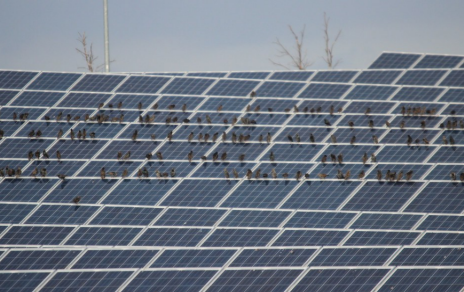Solar power will remain an essential form of industrial demand for silver in the decade ahead, analysts said this week.
The Silver Institute released a report at the start of the week, produced on its behalf by CRU Consulting, estimating that demand for silver in photovoltaic cells, used for solar power, will be a cumulative 888 million ounces between this year and 2030.
“We view this as a conservative estimate,” said Colin Hamilton, analyst with BMO Capital Markets, noting that his firm expects this figure to be higher at around 1.5 billion ounces from 2020 through 2030.
He commented that solar power is already the cheapest form of generating electricity in some emerging markets. Meanwhile, corporations are under pressure to reduce their carbon footprints at the same time that solar plants are becoming more economically viable.
CRU estimated that 100 million ounces of silver were used for PV cells in 2019, which the firm said was around 11% of total silver fabrication demand. CRU said it envisions the amount of silver required for PV cells will fluctuate between 70 million and 80 million ounces per year between 2024 and 2030, factoring in industry efforts to use less silver per PV cell but an overall increase in global PV capacity.
“While this amount is a small decline from the 2019 peak, it would be higher than any consumption level prior to 2016, and demonstrates that the PV sector will remain an important and consistent source of industrial demand for silver,” said the CRU report, written by Alex Laugharne.
In many instances, solar power is being encouraged by laws aimed at lowering carbon emissions, as well as tax policies. Solar power also is being increasingly used as a price-competitive option at industrial sites, especially those that are remote, such as mines in South Africa, Chile and Western Australia, according to the report. CRU said the cost of generating electricity from PV cells has rapidly declined over the past decade and, in many cases, is close to or below the cost of power generated by burning fossil fuels.
Fossil fuels accounted for around 62% of global electricity generation last year, CRU said. However, the firm said this will decline to 57% by 2025.
China is expected to account for some 40% of the world’s future increase in solar capacity through 2025, the CRU report said. Other increases expected by CRU include Europe, expected to increase solar capacity by 17%; North America, 12%; developed Asian countries, 10% collectively; and India, also 10%.
Chinese capacity to generate electricity via solar power has already increased dramatically, rising from just 0.16 gigawatts in 2006 to 205 in 2019. This is expected to grow to 414 GW in 2025, CRU said.
“A large part of the rapid rise has been in response to the energy demand associated with China’s continued development,” said CRU.
Meanwhile, the CRU report said, the potential substitution of cheaper metals cannot match silver in terms of energy output per solar panel. Silver has the highest electrical and thermal conductivity of any metal, CRU said.
Nevertheless, there has been “thrifting,” as the industry sought to use less silver per PV cell, particularly when the silver price doubled between 2009 and 2011, CRU said. This has meant the PV demand for silver has risen at a slower rate than overall PV demand itself, said the report.
“However, thrifting has its limits,” CRU said.
The amount of silver fell from 521 milligrams per cell in 2009 to 130 in 2016, the report said. Since the pace of reduction slowed to 111 MG per cell in 2019. CRU said it looks for silver content to drop some more during its forecast period, but leveling out at around 80 MG per cell.
“However, silver’s electro-conductive capabilities are not readily overcome, and solar PV manufacturers can only reduce silver loadings so much before performance and efficiency losses begin to outweigh whatever benefits are achieved from lower raw-material costs,” CRU said.
Further, non-silver PVs tend to be less reliable and have shorter lifespans, presenting serious issues for their widespread commercial development. Silver has the highest electrical and thermal conductivity of any metal, CRU said.






